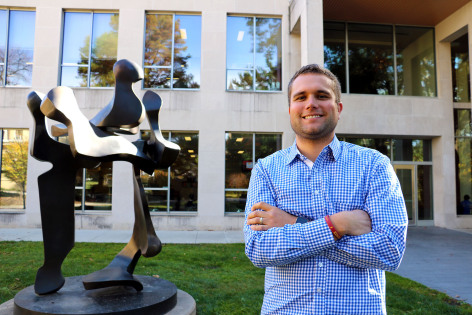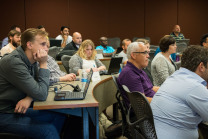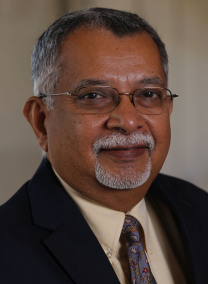
Joe Crispin is one of the first students to graduate with a Master of Business Analytics degree from Iowa State. Photos provided by College of Business
AMES, Iowa – The answers to some of the challenges businesses face can be found in the volumes of data many corporations collect. The problem is much of that data is messy and requires employees with the analytical skills to find the answers.
“The data is not always clean or complete,” said Sree Nilakanta, Kingland Graduate Director of Business Analytics in Iowa State University’s College of Business. “Corporations want someone who can identify problems, know where to find the data and then analyze it to solve the problem.”
With that in mind, Nilakanta and colleagues designed an online Master of Business Analytics program to help employees build their analytical skills. The interdisciplinary program addresses the challenges of dealing with data analytics and business intelligence in the “big data” environment. Nilakanta says the intention is to help businesses facing global competition and constant technological disruptions.
Students from the program’s first cohort, which started in 2015, will graduate this spring. That includes Joe Crispin, a sales engineer for a medical device manufacturer. Crispin says he’s seen an immediate and direct benefit from what he’s learned. By better understanding sales data, his company can better serve its customers.
“Most days we’re focused on hitting our sales goal. Decisions are made, but not data driven. Driving business decisions based on this data makes a lot more sense than just shooting blind,” Crispin said. “Now we can put together reports analyzing several years of data and forecast the next few months. It gives you power behind your decisions.”
Crispin is not the only one to see value in this data. He says his colleagues regularly come to him with projects and questions that utilize the skills he gained through the program.
Endless questions to answer
More information and advances in data processing tools and technology have driven the demand for data analysts. A 2016 report by the McKinsey Global Institute estimated a shortage of 250,000 data analysts, despite a 7 to 12 percent increase in graduates from data science and business analytics programs. However, corporations want more than statisticians or data scientists – they want employees who understand business, Nilakanta said.
Students in Iowa State’s program work for a variety of businesses with problems or issues they hope to address. For example, manufacturers of agricultural equipment want to use big data to predict the optimal time for machine maintenance. And insurance companies want to identify how many customers are taking advantage of specific policies and plans, and at what price point, Nilakanta said.
“Students have access to this fast and furiously growing amount of data. They also often have a gut feeling about a problem within their job. By analyzing the data, they can validate their gut feeling or disprove that feeling. Then they can go to a manager or project sponsor and convince them of the real problem or issue,” Nilakanta said.
Experience required
Iowa State’s 21-month program of study requires 30 credits of graduate level courses. Students must have a minimum two years of experience in a data-related field. Nilakanta says most average around nine years of experience, which gives them an understanding of the problems they are attempting to solve.
Students begin the program with a one-week, on-campus orientation class. They revisit campus midway through the program and at the end to complete and graduate on campus. The remainder of the class is held online.
The class structure was ideal for Crispin, who travels extensively for work. He likely couldn’t have completed the program without the flexibility and remote access to course materials and lectures. Crispin also appreciated the time spent on campus to collaborate with his fellow classmates.
“We’re all from different fields and there’s a lot of cross-industry knowledge,” Crispin said. “When we’re working on projects we all offer different suggestions on the type of data we should consider.”
You can learn more about the business analytics program here: http://www.business.iastate.edu/masters/business-analytics.

